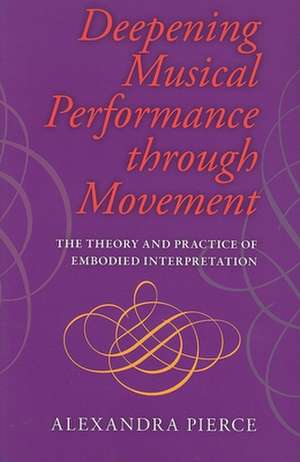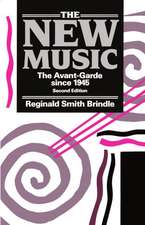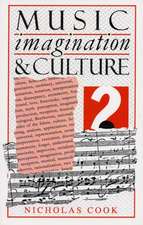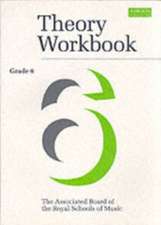Deepening Musical Performance through Movement – The Theory and Practice of Embodied Interpretation
Autor Roger Pierceen Limba Engleză Paperback – 25 feb 2010
Preț: 202.01 lei
Nou
Puncte Express: 303
Preț estimativ în valută:
38.65€ • 40.36$ • 31.99£
38.65€ • 40.36$ • 31.99£
Carte tipărită la comandă
Livrare economică 04-18 aprilie
Preluare comenzi: 021 569.72.76
Specificații
ISBN-13: 9780253222237
ISBN-10: 0253222230
Pagini: 248
Ilustrații: 90 b&w illustrations
Dimensiuni: 156 x 234 x 18 mm
Greutate: 0.42 kg
Editura: MH – Indiana University Press
ISBN-10: 0253222230
Pagini: 248
Ilustrații: 90 b&w illustrations
Dimensiuni: 156 x 234 x 18 mm
Greutate: 0.42 kg
Editura: MH – Indiana University Press
Cuprins
Acknowledgements; Introduction; To Performers; To Music Theorists; To Composers; To Movement Professionals; To Music Therapists; 1. Vitalizing the Musical Elements, One by One; Movement in the Studio and in Theory Teaching; Movement Becomes More Musical; Focusing and Refining Movement; Movement as a Schenkerian Discipline; Principles of Effective Movement; Movement Processes for Research and Teaching; 2. Mobilizing Balance; Balance and Grounding; Resting Balance, Sitting; A Familiar Class Scene; Resting Balance, Standing; Activated Balance and Tonic; The Sitting Balance Process and the Standing Balance Process; Carlos; Common Snares; The Games of Where Are You? and Where Am I?; Activated Balance and the Cadential Tonic; Spinal Flexibility; Sitting Sways; Standing Sways; The Swaying Process; Luisa; Swaying and Melody; Core Support; Recognizing Core Support; Luke; Core Support in Playing Phrase; Weight-Throwing into Action; Arm Swings; Weight-Throwing with Regard to Measure and Beat; Reabsorption and Completion of Action; Ending; The Game of Where Is It?; The Gracious Curve; Preliminary Experience; The Gracious Curve Process, Standing; The Gracious Curve Process, Sitting; The Gracious Curve Process and Playing Technique; Doing the pPocesses; 3. Melody Awakened: Seven Stages for Embodying Its Contour; Singing; Finding the Main Melody; Contouring Melody; Stage 1. Laddering the Pitches and Intervals; Stage 2. Emphasizing Continuity; Stage 3. Emphasizing Melody's Shape; Stage 4. Engaging the Whole Body; Stage 5. Swaying, to Take Contouring into Playing or Singing; Stage 6. Embodying the Nuances of Melody; Stage 7. Melody's Affect; 4. Resilience of Meter and Rhythm; Basics; Tony; Equality and Variety of Beats; Arm Swings, Side to Side; Tapping the Air; Metric Levels; Meter and Phrase; Detailed Experiences of Ping and Lilt; Sonya, Part 1; Balloon Tapping to Refine the Ping; Kendall; Sonya, Part 2; Soft-Springs; Hypermeasure Soft-Springs; Jonathan; Finding Rhythmic Clusters; Walking the Durations; Evelyn and Ricardo; 5. The Integration of Structural Levels ; Toward an Engaged Music Theory; Beginnings; Leading Questions; Fundamental Attributes of Schenkerian Sound: Coalescence, Middleground Rhythmic Vitality, and Span; Coalescence and Middleground Rhythmic Vitality; Coalescence as a Musical Quality; Kosta, Part 1; Middleground Rhythmic Vitality as a Musical Quality; Rachel; Coalescence and Middleground Rhythmic Vitality as Movement: Stepping; Eric; Kosta, Part 2; Coalescence and Middleground Rhythmic Vitality in a Nonmusical Context: Pole Vaulting; Jonathan; Other Contributors to Schenkerian Sound; Reluctance; Andrew; 6. Shaping Phrase with Span and Climax; Span as a Musical Quality ; Slow-motion Sculpting; Span as Movement: Hand-stretch; Jonathan; Arcing with an Arm to Find Performance Phrases; Kathy; Arm-Arcing to Find Span and Climax; Stepping and Stretching Spontaneously; Amy; A Chain of Processes: "Daphne am Bach"; Meter; Middleground Rhythmic Vitality; Span; Synthesis; 7. Letting Gesture Through: Reverberation ; Juncture and Reverberation; Reverberation as Expression; Sophie; Reabsorbing; Cutting off Reverberation; Nathan and Melissa; Embodying Reverberation; Joints; Joint Awareness; Joints and Touch; Joint Dance; Spinal Flexibility and Tone Quality; Spinal Flexibility and Melody; Jonathan and Valerie; 8. The Movements of Juncture; 9. Characterizing; Musical Character; Adrian, Part 1; Movement for Characterizing; Adrian, Part 2; Jennifer; 10. Tone of Voice; Notation and Tone of Voice; Musical Empathy; Arousing Tone of Voice; Descriptive Word; Vocal Inflection and Facial Response; Full-bodied Gestural Response; Touch; Adjectives and Adverbs; Quick Starts; Gargoyles; Aldo; Leah; Characterizing Movement versus Tone of Voice; Tone of Voice and Structural Levels; 11. The Spirit of Play ; Practicing Play; Recollecting; Imitating; Parody; Games to Invite Play; Fluent Continuity of Melody; Ping and Lilt in Hypermeter; Span of Phrase; Articulation of Phrases and Contrast of Phrase and Juncture); Characterizing; Ensemble and Showmanship; In a Nutshell; Aldo and MartaNotes; Bibliography; Index
Recenzii
"Whether you teach private or group instrumental or vocal lessons, music theory, composition, music therapy or music appreciation, you will find a wealth of ideas to use with your students." American Music Teacher
"This book brings all aspects of music to life via kinesthetic understanding. . . . Pierce's extensive research is obvious, but though the book assumes considerable knowledge of the discipline, personal anecdotes and musical references render it relatively easy to digest." Choice
"From this [book] . . . we receive these two gifts . . . a compositional repertoire distinct in imaginative focus and a pedagogy with wide application to music making and full of implications for research." The Open Space Magazine
"This book is not only a wonderful resource for therapists, musicians and music teachers, but also . . . a well-researched academic work." Structural Integrations
"Under the impetus of early influences as diverse as the Alexander technique, Rolfing, Schenkerian analysis and Stanislavski's Method acting. . . pianist, composer and music educator Alexandra Pierce has crystallized in this book a finely etched, lifetime quest to articulate the connection between the elements of music and the art of interpretation, through the prism of 'movement response to the music'." American String Teacher
"[Pierce] gives numerous examples of playing with movement to encourage a deeper way of hearing ... the musician's best musical performance and the composer's intentions ... [Deepening Musical Performance through Movement] is not a book to be read while sitting still." Journal of the IAWM
"Whether you teach private or group instrumental or vocal lessons, music theory, composition, music therapy or music appreciation, you will find a wealth of ideas to use with your students." American Music Teacher "This book brings all aspects of music to life via kinesthetic understanding... Pierce's extensive research is obvious, but though the book assumes considerable knowledge of the discipline, personal anecdotes and musical references render it relatively easy to digest." Choice "From this [book] ... we receive these two gifts ... a compositional repertoire distinct in imaginative focus and a pedagogy with wide application to music making and full of implications for research." The Open Space Magazine "This book is not only a wonderful resource for therapists, musicians and music teachers, but also ... a well-researched academic work." Structural Integrations "Under the impetus of early influences as diverse as the Alexander technique, Rolfing, Schenkerian analysis and Stanislavski's Method acting... pianist, composer and music educator Alexandra Pierce has crystallized in this book a finely etched, lifetime quest to articulate the connection between the elements of music and the art of interpretation, through the prism of 'movement response to the music'." American String Teacher "[Pierce] gives numerous examples of playing with movement to encourage a deeper way of hearing ... the musician's best musical performance and the composer's intentions ... [Deepening Musical Performance through Movement] is not a book to be read while sitting still." - Journal of the IAWM
"This book brings all aspects of music to life via kinesthetic understanding. . . . Pierce's extensive research is obvious, but though the book assumes considerable knowledge of the discipline, personal anecdotes and musical references render it relatively easy to digest." Choice
"From this [book] . . . we receive these two gifts . . . a compositional repertoire distinct in imaginative focus and a pedagogy with wide application to music making and full of implications for research." The Open Space Magazine
"This book is not only a wonderful resource for therapists, musicians and music teachers, but also . . . a well-researched academic work." Structural Integrations
"Under the impetus of early influences as diverse as the Alexander technique, Rolfing, Schenkerian analysis and Stanislavski's Method acting. . . pianist, composer and music educator Alexandra Pierce has crystallized in this book a finely etched, lifetime quest to articulate the connection between the elements of music and the art of interpretation, through the prism of 'movement response to the music'." American String Teacher
"[Pierce] gives numerous examples of playing with movement to encourage a deeper way of hearing ... the musician's best musical performance and the composer's intentions ... [Deepening Musical Performance through Movement] is not a book to be read while sitting still." Journal of the IAWM
"Whether you teach private or group instrumental or vocal lessons, music theory, composition, music therapy or music appreciation, you will find a wealth of ideas to use with your students." American Music Teacher "This book brings all aspects of music to life via kinesthetic understanding... Pierce's extensive research is obvious, but though the book assumes considerable knowledge of the discipline, personal anecdotes and musical references render it relatively easy to digest." Choice "From this [book] ... we receive these two gifts ... a compositional repertoire distinct in imaginative focus and a pedagogy with wide application to music making and full of implications for research." The Open Space Magazine "This book is not only a wonderful resource for therapists, musicians and music teachers, but also ... a well-researched academic work." Structural Integrations "Under the impetus of early influences as diverse as the Alexander technique, Rolfing, Schenkerian analysis and Stanislavski's Method acting... pianist, composer and music educator Alexandra Pierce has crystallized in this book a finely etched, lifetime quest to articulate the connection between the elements of music and the art of interpretation, through the prism of 'movement response to the music'." American String Teacher "[Pierce] gives numerous examples of playing with movement to encourage a deeper way of hearing ... the musician's best musical performance and the composer's intentions ... [Deepening Musical Performance through Movement] is not a book to be read while sitting still." - Journal of the IAWM
Notă biografică
Descriere
Applying gesture to explore performance, therapeutic, and compositional practices

















